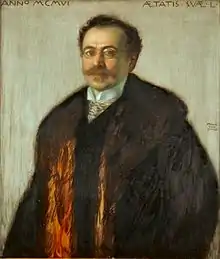Leo Graetz
Leo Graetz (26 September 1856 – 12 November 1941) was a German physicist. He was born in Breslau, Germany, and was the son of historian Heinrich Graetz.
Leo Graetz | |
|---|---|
 Leo Graetz, painted by Franz von Stuck (1906) | |
| Born | 26 September 1856 |
| Died | 12 November 1941 (aged 85) |
| Known for | Graetz number, Diode bridge |
Graetz was one of the first to investigate the propagation of electromagnetic energy. The Graetz number (Gz), a dimensionless number describing heat flow, is named after him.[1] Also sometimes known by his name is the diode bridge rectifier circuit that was invented by Polish electrotechnician Karol Pollak in 1896[2] and that was independently invented and published by Leo Graetz in 1897.[3]
In 1880 he confirmed the Stefan–Boltzmann law.[4]
Graetz died in Munich at age 85.
Publications
- Die Elektrizität und ihre Anwendungen (Electricity and Its Applications), Stuttgart 1903 Digital 17th edition from 1914 by the University and State Library Düsseldorf
- Handbuch der Elektrizität und des Magnetismus (Handbook of Electricity and Magnetism) - 5 volumes, 1918, 1921, 1923, 1920, 1928
- Recent developments in atomic theory, 1922
References
- See:
- Graetz, L. (1883). "Ueber die Wärmeleitungsfähigkeit von Flüssigkeiten" [On the heat conductivity of fluids]. Annalen der Physik und Chemie. 3rd series (in German). 18 (1): 79–94.
- Graetz, L. (1885). "Ueber die Wärmeleitungsfähigkeit von Flüssigkeiten [Part 2]" [On the heat conductivity of fluids]. Annalen der Physik und Chemie. 3rd series (in German). 25 (7): 337–357.
- That Karol ("Charles") Pollak had invented a diode bridge prior to Leo Graetz is mentioned in:
- (Graetz, 1897), p. 327 footnote.
- (Editorial staff) (24 June 1897). "Ein neues Gleichrichter-Verfahren" [A new method of rectification]. Elektrotechnische Zeitschrift (in German). 18 (25): 359 and footnote.
- See:
- Graetz, L. (1 May 1897). "Electrochemisches Verfahren, um Wechselströme in Gleichströme zu verwandeln" [Electrochemical method of changing alternating into direct currents]. Sitzungsberichte der Mathematisch-Physikalischen Classe der Königlich Bayerischen Akademie der Wissenschaften zu München (Transactions of the Mathematical-Physical Classes of the Royal Bavarian Academy of Sciences in Munich) (in German). 27: 223–228.
- Graetz, L. (1897). "Electrochemisches Verfahren, um Wechselströme in Gleichströme zu verwandeln" [Electrochemical method of changing alternating into direct currents]. Annalen der Physik und Chemie. 3rd series (in German). 62: 323–327.
- Graetz, Leo (22 July 1897). "Electrochemisches Verfahren, um Wechselströme in Gleichströme zu verwandeln" [Electrochemical method of changing alternating into direct currents]. Elektrotechnische Zeitschrift (in German). 18 (29): 423–424.
- Graetz, L. (1880). "Ueber das Gesetz der Wärmestrahlung und das absolute Emisssionsvermögen des Glases" [On the law of heat radiation and the absolute emissive power of glass]. Annalen der Physik und Chemie. 3rd series (in German). 11: 913–930.
This article is issued from Wikipedia. The text is licensed under Creative Commons - Attribution - Sharealike. Additional terms may apply for the media files.
